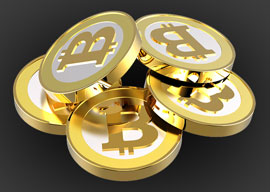
October 23, 2013

The form S-1 also spells out the dangers and opportunities related to the fund and the bitcoin network at large.
These dangers include the following:
1) continued worldwide growth in the adoption and use of bitcoins;
2) government and quasi-government regulation of bitcoins;
3) changes in consumer demographics and public tastes and preferences;
4) availability and popularity of other forms or methods of buying and selling goods and services, including new means of using fiat currencies; and
5) general economic conditions and the regulatory environment relating to [bitcoin-like] Assets.
So should you or I buy the stuff? Breaking the above five items down point-by-point:
1) Continued growth and the adoption of bitcoin usage seems certain; just wait until it hits the mainstream. We’re still in the early adopter phase of its life cycle. It’s a good place to be.
2) Governmental regulation of bitcoin is a known unknown. It is a possibly adverse condition that may kick in as, or before, BTC goes mainstream. (Bitcoin doesn’t need to reach a critical mass to be useful or hugely valuable, however. Part of its identity lies in the fact that it’s an alternative asset class.)
3) Demographics and public tastes will certainly swing massively in favor of bitcoin or bitcoin-like networks. That’s the point.
4) The popularity of other methods of buying and selling will, in my view, proliferate, and these may well include new means of using fiat currencies. The threat of this phenomenon to bitcoin is minor in that BTC is the industry leader and other entrants will be copycats reinforcing the alternative-currency habit as a whole. It’s safer than dollars or pounds, given the specter of quantitative easing, from which we suffer in the real world.
5) General economic conditions. Well, this is the punt you take on the direction of the global economy. And right now it is a highly favorable bet, in relative and in real terms. The armchair speculators are jumping back into the capital markets. Bitcoin in general, or the Winklevoss ETF specifically, is just one more exotic financial instrument into which investors can dive, now that (one hopes) the majority of game-changing exposures revealed by the 2008 crash have died out or been settled, now that some new wealth has been created and prosperity is not just a river in Egypt.
The beauty of BTC, however, is that it seems to grow increasingly valuable in harsh economic conditions. I can easily imagine another flight to bitcoin for sanctuary the next time the value of the euro or dollar gets really dicey.
We live in a multilateral world. What seems exciting is that while the dollar is the world’s reserve currency, and the Swiss franc is a stable holding currency, and while the euro is…Europe’s grand experiment…we have yet to see exactly what kind of “character” the bitcoin possesses. Right now it’s little more than a risk-on growth stock. Speculative investment into BTC vies”for now, it juices the upward momentum”with the bitcoin’s steady adoption by the world’s more utilitarian cyber citizens.
Last question: Is bitcoin money?
According to Max Keiser in the Huffington Post earlier this year, BTC fulfills all four of Aristotle’s conditions for the definition of money. If it is to be money, bitcoin must be: 1) durable, 2) portable, 3) divisible, and 4) of intrinsic value. Keiser argues well that it meets these conditions.
The ultimate question is: Without being a fiat currency such as the dollar or yen, how far and how wide can bitcoin grow? And if the day comes when it joins the ranks of legal tender”meaning that the money’s backed by the full faith and credit of the government that issues”what next?
The future’s waiting for us to decide what works best.